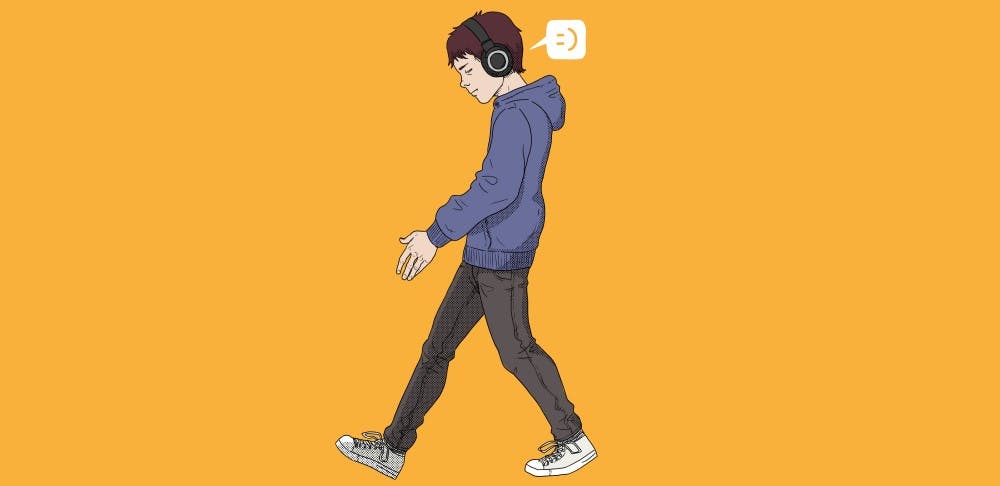There is a Youtube Live station with a constant 10,000–person viewership of a looped video of an anime girl sitting at a desk, looking tired and staring at a whole stack of work to her right as music plays in the background. The live chat is a constant stream of 4:20 blazers, depressed 14 year–olds looking for solace in other depressed 14 year–olds, and music heads from all across the globe. It’s a journey back through the ether of internet chat rooms, but the project is a new venture by Chillhop Music, a promoter of different artists that all make the same kind of transient synth–wave instrumentals. This music is called Lo–Fi Hip Hop and it has already overtaken your taste in music without you even knowing it.
Lo–fi hip–hop has roots in much of the DIY music scene of the past 20 years. In terms of genre origins, the sound itself comes from the production process in lo–fi music (that is, music that is recorded at a lower quality than the standard hi–fi). This give the sound a slight distortion, almost as if the recording was muffled on purpose. Many artists from the '90s achieved this sound by using old recording equipment of the '70s, creating hypnagogic pop, a genre that Wire journalist James Keenan once described as music that is somewhere “between waking and sleeping.” Today you can find artists such as the ever–strange Ariel Pink creating this same intoxicating rhythm. This muffled sound was then repurposed by hip–hop producers such as J Dilla and Madlib of Stone’s Throw Records. This record label is known for its constant creation of new wave music with old wave sound, so it is no surprise that their new prodigy Knxwledge is constantly reinterpreting old jazz and soul tunes in a chopped & screwed methodology to give it that new old–timey sound. Contradictory from the get–go, this type of music catches the ear of all listeners. It's a form of music that has always felt out of place, like a relic from the past with a futuristic undertone.
The music was and still very much is an underground scene. Most lo–fi beat artists got their start from Adult Swim “bumps”, an intra–commercial 30 second–long scene that helped break up the absurdity of their programming. If you were like me and up at 3 am watching old One Piece and Cowboy Bebop reruns during Toonami, you definitely encountered the lo–fi beats of Flying Lotus and countless other artists that seeped into your subconscious without you properly recognizing how much you enjoyed it. Maybe it's because we're a vulnerable species during the twilight, but the sounds aired during those breaks resonated with the listeners enough to create the musical environment we are surrounded with today.
Today, lo–fi hip hop has created a subculture of its own within the popular culture of hip hop. If you ask any listeners of lo–fi what they get out of it, they will say that they're great “chill beats” for studying and relaxing. Oh, and trying to freestyle with your five wannabe rapper friends while you pass around a joint that makes you feel like you have the spitting abilities of a young Fabolous. With samples from simple jazz chords, often from one artist looped overly saturated anime imagery, the music creates a multi–medial stylistic appeal. With its combination of heavy–based hip–hop layered with video game sound references, a nod to its core fanbase of modern day cool kids, the music strikes a chord (please punch me now) with its audience that creates a feeling of true nostalgia.
Just to spit some extra knowledge, if you enjoy Soundcloud rappers, you probably enjoy lo–fi hip–hop beats. The entire culture of lo–fi hip hop has stemmed through the collaborative efforts of Soundcloud and Bandcamp artist, as they all sample the same stuff. Most instrumentals today you hear are often different interpretations of an original ‘loop’ one artist sampled from another. Popular artists such as Isaiah Rashad and J Cole use these relaxed beats as a way to create a vibe where there words are not drowned out by the heavy rolling base of 808s or the constant high hats of modern day trap music. Instead, their words flow with the beat, another layer of muffling over the transient instrumentals. This shadow culture within modern hip hop is clearly making its way to the forefront.
Lo–fi hip hop is important. Its universality of sampling allows it to find an audience in almost any type of listener. It can be played across all age groups as it also embodies the characteristics of furniture or elevator music (music that can be played without causing any sort of disturbance). It fits perfectly into any background, but also creates a cloudy mood (smoke clouds of course). More so, it is so low key right now that as part of the Soundcloud culture, artists are willing to share their efforts and allow for sampling upon sampling, thereby giving the masses millions of ways to listen to this type of music on a comfortable and cheap platform. Within this new age of constant creation, listeners can easily become creators of this type of music, bringing themselves into this world of video games, jazz, and anime. Music is clearly evolving around this new sub–genre as the type of rap we're beginning to enjoy continues to put less of an emphasis on the lyrics, but rather on the sound the artists voice creates in combination with the instruments. It's basically the opposite end of the Migos spectrum.
In short, you should check out this music. The best place to start is Youtube, as there are many channels that have 24–hour lo–fi hip hop beats of artists like Jaeden Camstra, a 17 year–old Texan who embodies everything you love and hate about Soundcloud artists (but fuck, his beats are great), Idealism and Jinsang. One channel, STEEZYASFUCK (lmao), is a constant promoter of new mixes created by different lo–fi artists. Just start clicking around; it's all enjoyable. Even if you aren’t the biggest fan of one artist, the music takes up such little space in the room that you don’t have to worry about even disturbing yourself. Just relax, grab a nice book, and feel yourself chill out to beats that you probably already loved without knowing their origins.







